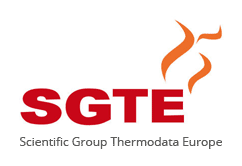- SGTE - Scientific Group Thermodata Europe
- Thermochemical Databases
- SGTE Nuclear Database
SGTE Nuclear Database
The SGTE Nuclear Database has been generated by now dissolved company Thermodata, Grenoble, as part of a much bigger database effort to cover many thermochemical aspects related to the field of nuclear reactors. This database is specially made for the investigation of in-vessel chemical reactions.
For database information document, please click here:
![]() (PDF, 301K)
(PDF, 301K)
The elements included in the database are O, U, Zr, Fe, Cr, Ni, Ar, H
Also included are systems formed among the 6 oxides UO2, ZrO2, FeO, Fe2O3, Cr2O3, NiO
The database covers the entire composition range from pure metal to oxide regions and contains critically evaluated thermodynamic parameters for all relevant multicomponent condensed or gaseous substances and solution phases.
General comments:
Comparative calculations have been made for all the assessed binary and ternary systems contained in the database, with the purpose of checking the agreement with the experimentally observed properties for each system. It should nevertheless be borne in mind that the amount of published information varies significantly both in quantity and quality from system to system so that, while every effort has been made to provide the best data possible, there is still a degree of uncertainty associated with calculated results. In particular, due to an absence of experimental data for the systems Cr2O3-UO2, Cr2O3-ZrO2, Fe2O3-ZrO2, NiO-UO2 and NiO-ZrO2, it was necessary to use estimation techniques to obtain required values. Consequently, particular care should be exercised in interpreting calculated results when these oxide combinations are involved.
In a binary system, if no assessed mixing parameters are available for a particular phase, the phase will be treated as ideal. Correspondingly, the properties of a ternary or higher-order phase will be calculated applying the appropriate models used in the database. This procedure may give useable results if the alloy compositions in question are close to a pure component or to a binary edge for which assessed data are available. However, results of calculations for other composition ranges should be treated with extreme caution.
Contact person:












